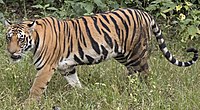
Photo from wikipedia
Genomic data have the potential to inform high resolution landscape genetic and biological conservation studies that go far beyond recent mitochondrial and microsatellite analyses. We characterize the relationships of populations… Click to show full abstract
Genomic data have the potential to inform high resolution landscape genetic and biological conservation studies that go far beyond recent mitochondrial and microsatellite analyses. We characterize the relationships of populations of the foothill yellow-legged frog, Rana boylii, a declining, “sentinel” species for stream ecosystems throughout its range in California and Oregon. We generated RADseq data and applied phylogenetic methods, hierarchical Bayesian clustering, PCA and population differentiation with admixture analyses to characterize spatial genetic structure across the species range. To facilitate direct comparison with previous analyses, we included many localities and individuals from our earlier work based on mitochondrial DNA. The results are striking, and emphasize the power of our landscape genomic approach. We recovered five extremely differentiated primary clades that indicate that R. boylii may be the most genetically differentiated anuran yet studied. Our results provide better resolution and more spatially consistent patterns than our earlier work, confirming the increased resolving power of genomic data compared to single-locus studies. Genomic structure is not equal across the species distribution. Approximately half the range of R. boylii consists of a single, relatively uniform population, while Sierra Nevada and coastal California clades are deeply, hierarchically substructured with biogeographic breaks observed in other codistributed taxa. Our results indicate that clades should serve as management units for R. boylii rather than previously suggested watershed boundaries, and that the near-extinct population from southwestern California is particularly diverged, exhibits the lowest genetic diversity, and is a critical conservation target for species recovery.
Journal Title: Heredity
Year Published: 2018
Link to full text (if available)
Share on Social Media: Sign Up to like & get
recommendations!